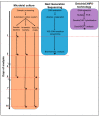The DendrisCHIP® Technology as a New, Rapid and Reliable Molecular Method for the Diagnosis of Osteoarticular Infections
- PMID: 35741163
- PMCID: PMC9222036
- DOI: 10.3390/diagnostics12061353
The DendrisCHIP® Technology as a New, Rapid and Reliable Molecular Method for the Diagnosis of Osteoarticular Infections
Abstract
Osteoarticular infections are major disabling diseases that can occur after orthopedic implant surgery in patients. The management of these infections is very complex and painful, requiring surgical intervention in combination with long-term antibiotic treatment. Therefore, early and accurate diagnosis of the causal pathogens is essential before formulating chemotherapeutic regimens. Although culture-based microbiology remains the most common diagnosis of osteoarticular infections, its regular failure to identify the causative pathogen as well as its long-term modus operandi motivates the development of rapid, accurate, and sufficiently comprehensive bacterial species-specific diagnostics that must be easy to use by routine clinical laboratories. Based on these criteria, we reported on the feasibility of our DendrisCHIP® technology using DendrisCHIP®OA as an innovative molecular diagnostic method to diagnose pathogen bacteria implicated in osteoarticular infections. This technology is based on the principle of microarrays in which the hybridization signals between oligoprobes and complementary labeled DNA fragments from isolates queries a database of hybridization signatures corresponding to a list of pre-established bacteria implicated in osteoarticular infections by a decision algorithm based on machine learning methods. In this way, this technology combines the advantages of a PCR-based method and next-generation sequencing (NGS) while reducing the limitations and constraints of the two latter technologies. On the one hand, DendrisCHIP®OA is more comprehensive than multiplex PCR tests as it is able to detect many more germs on a single sample. On the other hand, this method is not affected by the large number of nonclinically relevant bacteria or false positives that characterize NGS, as our DendrisCHIP®OA has been designed to date to target only a subset of 20 bacteria potentially responsible for osteoarticular infections. DendrisCHIP®OA has been compared with microbial culture on more than 300 isolates and a 40% discrepancy between the two methods was found, which could be due in part but not solely to the absence or poor identification of germs detected by microbial culture. We also demonstrated the reliability of our technology in correctly identifying bacteria in isolates by showing a convergence (i.e., same bacteria identified) with NGS superior to 55% while this convergence was only 32% between NGS and microbial culture data. Finally, we showed that our technology can provide a diagnostic result in less than one day (technically, 5 h), which is comparatively faster and less labor intensive than microbial cultures and NGS.
Keywords: biochips; bone and joint infection; in vitro multiplex diagnostic; microbial cultures; next-generation sequencing.
Conflict of interest statement
E.B., T.P., M.P., Y.C., A.A., T.C. and S.P. are employees of Dendris SAS. While R.F. is a founding sponsor of Dendris SAS, he had no role in the design of the study, analyses, and interpretation of data.
Figures




Similar articles
-
Rapid and Accurate Diagnosis of Dermatophyte Infections Using the DendrisCHIP® Technology.Diagnostics (Basel). 2023 Nov 11;13(22):3430. doi: 10.3390/diagnostics13223430. Diagnostics (Basel). 2023. PMID: 37998565 Free PMC article.
-
Innovative DendrisChips® Technology for a Syndromic Approach of In Vitro Diagnosis: Application to the Respiratory Infectious Diseases.Diagnostics (Basel). 2018 Nov 11;8(4):77. doi: 10.3390/diagnostics8040077. Diagnostics (Basel). 2018. PMID: 30423863 Free PMC article.
-
Targeting the 16S rRNA Gene by Reverse Complement PCR Next-Generation Sequencing: Specific and Sensitive Detection and Identification of Microbes Directly in Clinical Samples.Microbiol Spectr. 2023 Jun 15;11(3):e0448322. doi: 10.1128/spectrum.04483-22. Epub 2023 May 25. Microbiol Spectr. 2023. PMID: 37227289 Free PMC article.
-
Methods in virus diagnostics: from ELISA to next generation sequencing.Virus Res. 2014 Jun 24;186:20-31. doi: 10.1016/j.virusres.2013.12.007. Epub 2013 Dec 19. Virus Res. 2014. PMID: 24361981 Review.
-
Candida and candidaemia. Susceptibility and epidemiology.Dan Med J. 2013 Nov;60(11):B4698. Dan Med J. 2013. PMID: 24192246 Review.
Cited by
-
Dendrimers, an Emerging Opportunity in Personalized Medicine?J Pers Med. 2022 Aug 19;12(8):1334. doi: 10.3390/jpm12081334. J Pers Med. 2022. PMID: 36013283 Free PMC article. Review.
-
Rapid and Accurate Diagnosis of Dermatophyte Infections Using the DendrisCHIP® Technology.Diagnostics (Basel). 2023 Nov 11;13(22):3430. doi: 10.3390/diagnostics13223430. Diagnostics (Basel). 2023. PMID: 37998565 Free PMC article.
-
Exploring the impact of pathogenic microbiome in orthopedic diseases: machine learning and deep learning approaches.Front Cell Infect Microbiol. 2024 Apr 3;14:1380136. doi: 10.3389/fcimb.2024.1380136. eCollection 2024. Front Cell Infect Microbiol. 2024. PMID: 38633744 Free PMC article. Review.
References
LinkOut - more resources
Full Text Sources

